Mycelium Market
The market for mycelium is estimated at USD XX million in 2024; it is projected to grow at a CAGR of XX% to reach USD XX million by 2029. The global push towards carbon neutrality has created a lucrative market for environmentally conscious and sustainable goods. This trend is particularly evident in the food and beverage sector, with North American and European markets leading the way. For instance, the United States experienced a notable 7% increase in plant-based meat retail sales, reaching $8 billion in 2022. Such market dynamics suggest that mycelium-based products present a promising alternative to traditional animal-derived food items, aligning with growing consumer preferences for sustainable nutrition.
Global Mycelium Market Trends
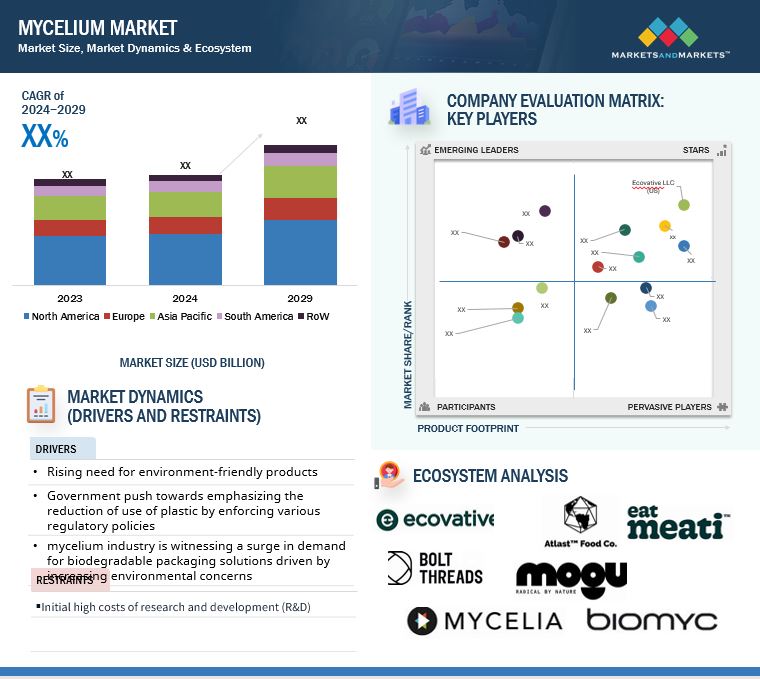
Attractive Opportunities for Players in The Mycelium Market
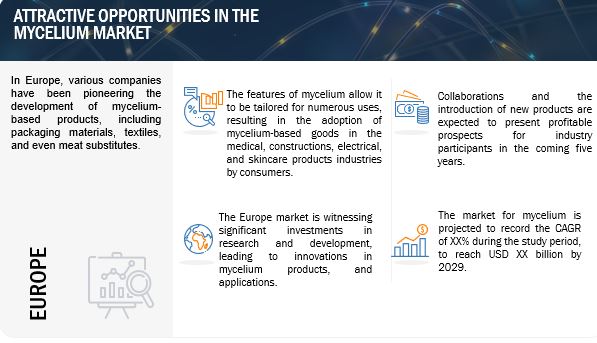
Drivers:
A surge in demand for biodegradable packaging solutions
Mycelium-derived biodegradable packaging has captured significant industry attention as a groundbreaking sustainable alternative. Research demonstrates that mycelium-based materials can replicate polystyrene characteristics, enabling diverse applications from organic plastics to furniture. Its lightweight composition and manufacturing flexibility make it particularly suitable for packaging, especially in shipping and delivery contexts. Moreover, the cost-effectiveness of raw materials and disposal processes positions mycelium as a potential solution to emerging environmental challenges.
Characterized by an intricate, thread-like root structure, mycelium offers remarkable versatility in material production. Its applications span multiple sectors, including textiles, nutrition, construction, and packaging. Innovators have successfully transformed mycelium into products ranging from leather substitutes to plant-based foods, presenting an environmentally friendly alternative to conventional plastic materials. The substance's adaptable nature allows it to be molded into various forms, with mycelium foam emerging as a particularly promising packaging solution.
Major e-commerce platforms like Amazon, eBay, and Etsy have long been scrutinized for their substantial environmental impact, particularly regarding packaging practices. Growing consumer consciousness has intensified demands for waste reduction and more sustainable packaging technologies. Mycelium-based packaging represents a responsive innovation addressing these environmental concerns, offering a promising pathway to more eco-friendly shipping and product protection methods.
Restraints:
Regulatory and Standardization Issues
The regulatory and standardization landscape for mycelium-based materials represents a critical bottleneck in the market's potential for widespread adoption, characterized by a complex web of scientific, legal, and industry-specific challenges. Unlike established materials with well-defined regulatory frameworks, mycelium technologies exist in a nascent regulatory environment that lacks comprehensive guidelines across multiple industries. In the food and beverage sector, regulatory bodies like the FDA and European Food Safety Authority face significant challenges in classifying and approving mycelium-based products, particularly those intended as meat alternatives or nutritional supplements. The novel nature of these materials requires extensive safety assessments, toxicological studies, and long-term impact evaluations that can be both time-consuming and financially prohibitive for emerging companies.
In the packaging and materials industries, standardization becomes even more complex. Current regulatory frameworks are predominantly designed for traditional synthetic and organic materials, creating substantial gaps in assessment protocols for biomaterials like mycelium. Certification processes struggle to evaluate the unique properties of mycelium-based products, including their biodegradability, structural integrity, and environmental impact. Unlike conventional materials with established testing methodologies, mycelium requires developing entirely new standards that can capture its living, dynamic characteristics. This challenge extends to multiple domains, including construction, textiles, and electronics, where existing regulatory mechanisms are ill-equipped to comprehensively assess the performance and safety of mycelium-derived materials.
Opportunities:
Material Innovations
Mycelium stands at the forefront of a revolutionary material innovation landscape, offering unprecedented possibilities across multiple industries through its unique biological properties and remarkable versatility. At its core, mycelium—the root-like network of fungal threads—presents a groundbreaking platform for material development that challenges traditional manufacturing paradigms. In textile production, mycelium-derived materials are emerging as sophisticated alternatives to leather, creating bio-based fabrics that mimic the texture, durability, and aesthetic appeal of animal leather while eliminating environmental and ethical concerns associated with conventional leather production. Companies are developing mycelium-based textiles that can be grown in controlled environments, requiring minimal resources and producing negligible waste compared to traditional textile manufacturing processes.
The construction industry represents another frontier of mycelium material innovation. Researchers and architects are exploring mycelium-based composites that can serve as sustainable insulation, structural components, and even entire building materials. These mycelium composites demonstrate exceptional thermal insulation properties, fire resistance, and structural integrity, while simultaneously offering a carbon-negative alternative to traditional construction materials. The ability to grow these materials in specific molds allows for unprecedented design flexibility, enabling architects and designers to create complex, custom-shaped building components that would be challenging or impossible to produce using conventional manufacturing techniques.
Challenges:
High R&D Costs, Lack of Awareness and Regulatory Standards
The mycelium market is likely to be vulnerable to some factors that are anticipated to hamper the market expansion over the forecast period. For example, the high costs associated with the research and development of mycelium products as well as the production costs of mycelium is a contributing factor in the decline in demand for mycelium. In addition, the consumers may not be aware of the benefits of adoption of mycelium. This results in limited adoption of mycelium, thus affecting the market growth. Furthermore, regulatory standards regarding the use of mycelium in food & beverage as well as packaging industry among others is likely to impede the market growth.
Mycelium Market Ecosystem
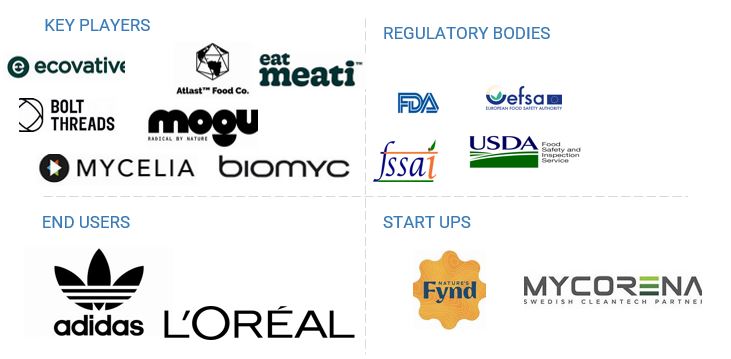
Prominent companies in this market include well-established, financially stable manufacturers of mycelium products. These companies have been operating in the market for several years and possess a diversified product portfolio, state-of-the-art technologies, and strong global sales and marketing networks. Prominent companies in this market include Ecovative Design LLC. (US), MYFOREST Foods (US), Meati Inc. (US), Mycelia (Belgium), Biomyc (Bulgaria).
Based on nature, the processed sub-segment is projected to have a significant share in the market.
Processed mycelium emerged as a dominant segment of the overall revenue share in 2024. Processed mycelium, on the other hand, refers to raw mycelium that has undergone specific treatments and procedures to achieve desired characteristics or forms. Processing techniques can include methods such as drying, heat treatment, chemical treatments, and moulding. These processes can be used to create mycelium-based materials with specific shapes, sizes, and properties.
Processed mycelium can be moulded into various forms, making it suitable for applications including packaging, construction materials, and even consumer goods. During processing, mycelium can be combined with other organic materials or additives to enhance its durability, strength, and suitability for applications. Processed mycelium products often undergo rigorous testing to ensure they meet quality standards and can perform effectively in their intended uses.
The pre-formed is the fastest growing segment in the mycelium market is projected to have a significant share.
The pre-formed mycelium market has seen significant growth in recent years, offering innovative and eco-friendly solutions across various industries.
A key driver of this growth is the rising demand for sustainable alternatives in sectors like packaging, construction, and consumer goods. With growing awareness of the environmental impact of conventional materials, both businesses and consumers are increasingly opting for mycelium-based products due to their biodegradability and low environmental footprint. Another major factor fueling market expansion is the versatility of pre-formed mycelium products. These materials can be molded into diverse shapes and sizes, making them ideal for applications such as protective packaging, insulation, decorative items, and furniture components.
The Europe region is anticipated to experience rapid growth between 2024 and 2029.
Europe dominated the global market in 2024 and is projected to retain its leading position in the coming years. Mycelium, the vegetative structure of fungi, has emerged as a viable alternative to conventional materials like plastic and leather. Numerous European companies are at the forefront of innovation, producing mycelium-based packaging, textiles, and meat substitutes. This growth aligns with the region's dedication to environmental sustainability and the principles of a circular economy, making mycelium an appealing option for businesses and consumers prioritizing eco-friendly solutions.
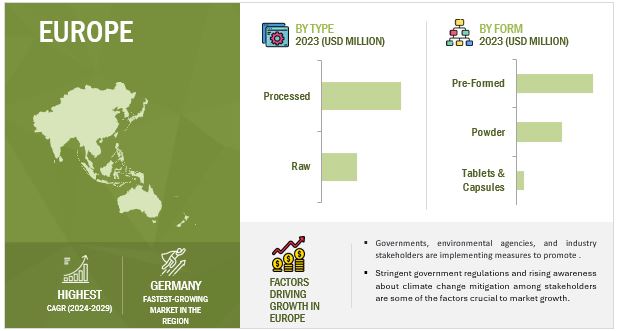
Key Market Players
- Ecovative design LLC (US)
- Myforest Foods (US)
- Meati Inc. (US)
- Bolt Threads Inc. (US)
- Mycelia (Bulgaria)
- Biomyc (Bulgaria)
- Nature’s Fynd (UK)
- Kingdom Supercultures (US)
- Mogu (Italy)
- Myco Technology (US)
These market players are focusing on increasing their presence through agreements and collaborations. These companies have a strong presence in North America, Asia Pacific, South America and Europe. They also have manufacturing facilities along with strong distribution networks across these regions.
Recent Developments
- In March 2023, Better Meat Co established its first-ever Scientific Advisory Board (SAB). The board consists of leading authorities in filamentous fungi, cell biology, metabolism, genetics, and food safety, which supports The Better Meat Co's initiatives to improve the use of mycelium in applications for both hybridized and animal-free meat.
- In November 2022, to create and market the "next generation of mycelium materials" for footwear, clothing, and accessories, Ecovative LLC partnered with premium leather manufacturer Ecco Leather, a division of the Danish footwear giant Ecco.
- In January 2023, MyForest Foods Co. announced the launch of a new product named My Jerky. Similar to MyBacon, which is a vegan alternative to pork bacon, MyJerky is a mycelium-based alternative to beef jerky.
Frequently Asked Questions (FAQ):
What is the current size of the mycelium market?
The mycelium market is estimated at USD xx million in 2024 and is projected to reach USD xx million by 2029, at a CAGR of xx% during the same period.
Which are the key players in the market, and how intense is the competition?
Ecovative Design LLC. (US), MYFOREST Foods (US), Meati Inc. (US). The market for mycelium is expanding rapidly, with more mergers, acquisitions, and product launches. Companies in this sector are also heavily investing in research and development.
Which region is projected to account for the largest share of the mycelium market?
The Europe market is expected to dominate during the forecast period. The region currently stands as a formidable force in the mycelium market, boasting dominance fueled by a convergence of factors, including robust research and development initiatives and the presence of major key players with advanced manufacturing capabilities.
What kind of information is provided in the company profiles section?
The provided company profiles deliver crucial details, including a thorough business summary that covers different segments, financial results, geographic presence, revenue distribution, and business revenue breakdown. They also offer insights into product lines, key achievements, and expert analyst opinions to better illustrate the company's potential.
What are the factors driving the mycelium market?
Rising need for environment-friendly products, Government push towards emphasizing the reduction of use of plastic by enforcing various regulatory policies, mycelium industry is witnessing a surge in demand for biodegradable packaging solutions driven by increasing environmental concerns.





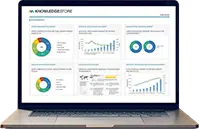








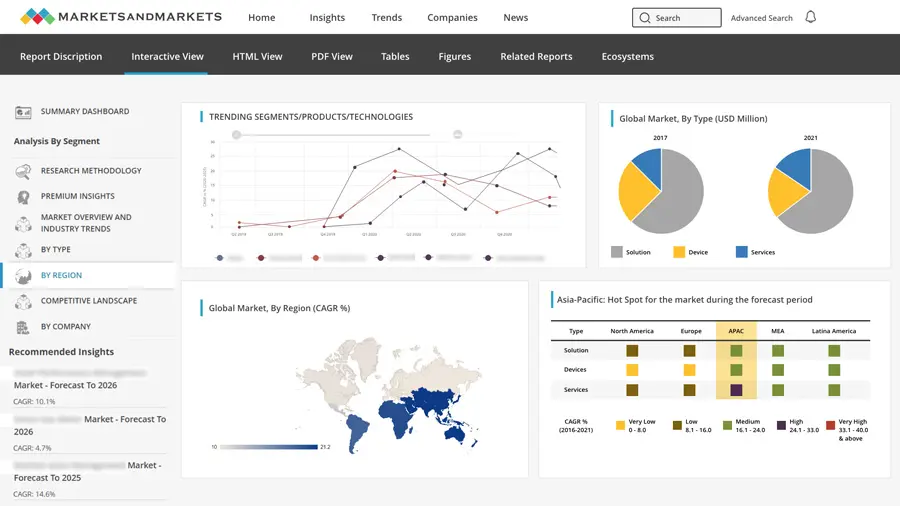
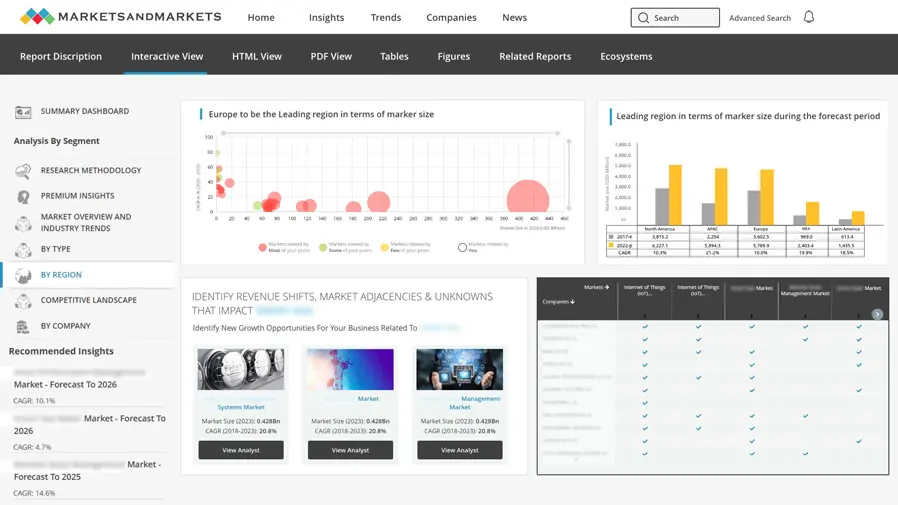
Growth opportunities and latent adjacency in Mycelium Market